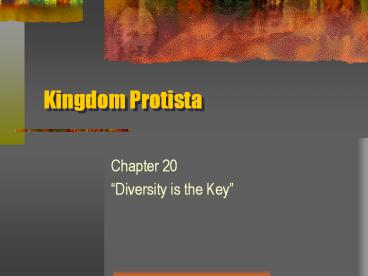Kingdom Protista - PowerPoint PPT Presentation
1 / 18
Title:
Kingdom Protista
Description:
Chapter 20 Diversity is the Key What is a protist? Unicellular Eukaryotic Classified into 3 general categories Animal like Plant like Fungus like *Based on mode ... – PowerPoint PPT presentation
Number of Views:65
Avg rating:3.0/5.0
Title: Kingdom Protista
1
Kingdom Protista
- Chapter 20
- Diversity is the Key
2
What is a protist?
- Unicellular
- Eukaryotic
- Classified into 3 general categories
- Animal like
- Plant like
- Fungus like
- Based on mode of metabolism
3
Animal Like Protists
- Classified by movement
- Zooflagellates
- Sarcodines
- Ciliates
- Sporozoans
4
Zoomastigina
- Euglena, Trypanasoma
- Flagellates move by using a whip like tail
- Have red pigmented eyespot for detecting light
5
Sarcodina
- Amoeba proteus
- Move and eat using psuedopods
- Flexible and active
- Fresh and Salt Water
6
Ciliophora
- Paramecium/Vorticella
- Move by using cilia
- Macronucleus-day to day
- Micronucleus-chromosomes and DNA
- Stentor to the right?
- Fresh and Salt Water
- Contractile Vacuoles to remove water
7
Sporozoa
- Plasmodium
- Reproduce using spores
- Parasites, carried by insects
- Plasmodium causes malaria
8
Plant Like Protists
- Classified by color
- Diatoms
- Dinoflagellates
- Red Algea
- Brown Algea
- Green Algea
9
Bacillariophyta
- Diatoms
- Contain carotenoids for their gold pigments
- Have geometric shells that are cell walls made of
silica - Marine and Freshwater
- Many Uses (glass,toothpaste, soil component)
10
Pyrrophyta
- Dinoflagellates
- Double flagella
- Can secrete toxins in Red Tide (found in
shellfish) - Not all toxic, give off light
11
Rhodophyta
- Red Algae
- Absorbs blue wavelengths of light allowing them
to live deeper in the water column - Helps build coral reefs
12
Phaeophyta
- Brown algae/Kelp
- Largest of the algae
- Can grow up to 60 m
- Closely related to land plants in structure
- Mostly marine
13
Giant Kelp
14
Chlorophyta
- Volvox, Ulva
- Most numerous of all plantlike protists
- Fresh and marine water, green algae
- Most attach to rocks
- Ulva shown to the right?
15
Fungus Like Protists
- Classified by reproduction
- Cellular Slime Molds
- Acellular Slime Molds
- Water Molds
16
Acrasiomycota
- Cellular Slime Molds
- Move like amoeba
- Reproduce with spores from fruiting body and
undergo cell division? - When food runs out, spores are released
17
Myxomycota
- Plasmodial Slime Molds
- Considered a giant bag of cytoplasm with many
nuclei - Reproduce by spores from sporangia
- Extend vein like structures to absorb decaying
food - Can grow several meters
18
Oomycota
- Water molds and downy mildews
- Saprophytic or Parasitic
- Thrive on detritus in the water
- Make hyphae or thin filaments ?
- Alternate b/t sexual and asexual reproduction































